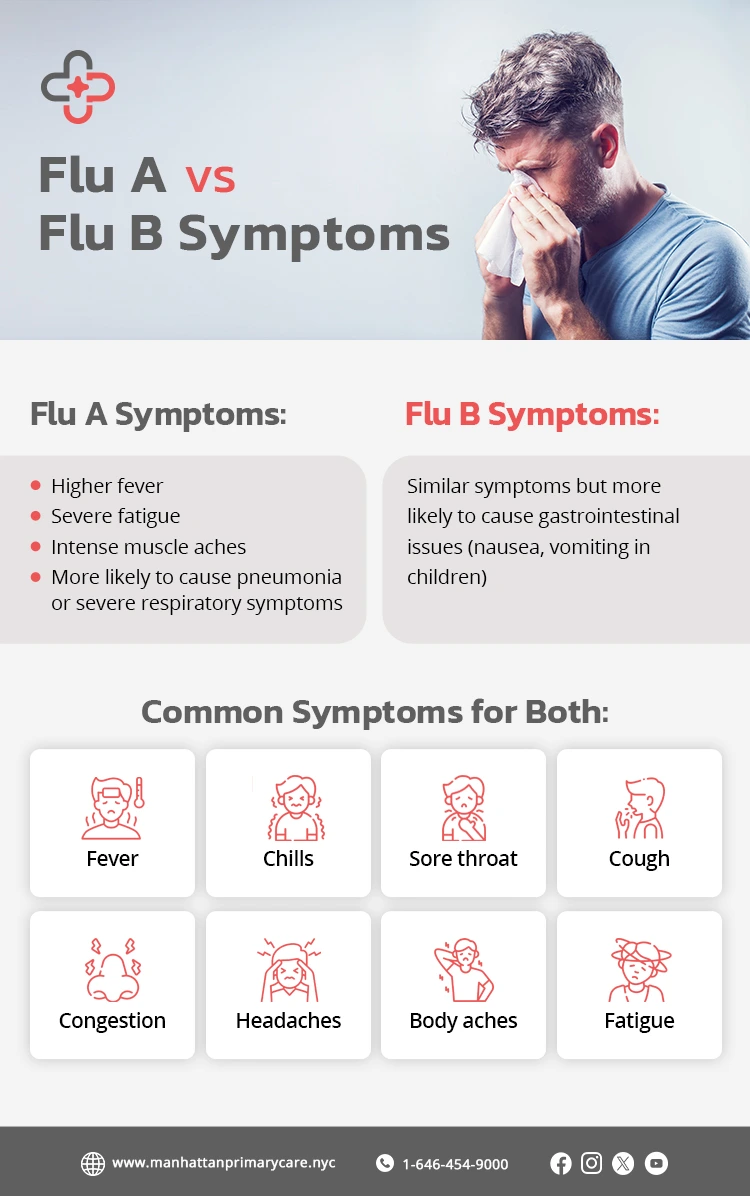You’re feeling achy, feverish, and exhausted. You go to the doctor, and they tell you that you have the flu, but is it Type A or Type B? And does it really matter?
Absolutely! While both Influenza A and B cause seasonal flu, they differ in severity, symptoms, and treatment options. Some flu seasons are dominated by Type A, while others see a surge in Type B cases. Understanding these differences can help you take the right precautions and seek timely treatment.
Flu Type A vs B: What’s the Difference?
Influenza A and B are both caused by influenza viruses, but they have key distinctions:
- Influenza A:
- Infects humans and animals (birds, pigs, etc.).
- More likely to mutate, leading to new strains each year.
- Can cause pandemics (e.g., H1N1 Swine Flu, H5N1 Bird Flu).
- Influenza B:
- Only infects humans.
- Mutates more slowly than Type A.
- Typically appears later in flu season.
Which Flu Is Worse A or B?
Influenza A is generally considered more severe because it mutates rapidly and can jump between species, increasing pandemic potential. However, Flu B can still be dangerous, particularly for children and the elderly.
Factors influencing severity:
- Age & Risk Factors: Flu B can be particularly dangerous for younger children and older adults.
- Flu Season Trends: Some years, Flu B cases surpass Flu A.
- Complications: Both Flu A and B can lead to pneumonia, hospitalization, and even death.
Flu A vs Flu B Symptoms


Flu A Symptoms:
- Higher fever
- Severe fatigue
- Intense muscle aches
- More likely to cause pneumonia or severe respiratory symptoms
Flu B Symptoms:
- Similar symptoms but more likely to cause gastrointestinal issues (nausea, vomiting in children)
Common Symptoms for Both:
- Fever, chills
- Sore throat, cough
- Congestion, headaches
- Body aches, fatigue
Flu A and B Treatment Differences
Antiviral Medications:
- Oseltamivir (Tamiflu) and Baloxavir (Xofluza) work for both Flu A and B if taken within 48 hours of symptom onset.
- Some Flu A strains may show antiviral resistance.
Home Remedies & Care:
- Stay hydrated and rest.
- Use fever reducers like acetaminophen (Tylenol) or ibuprofen (Advil).
- Avoid antibiotics unless there is a secondary bacterial infection.
How Does the Flu Spread? Transmission & Severity
Flu spreads through respiratory droplets from coughing, sneezing, or touching contaminated surfaces. However, Flu A spreads more easily due to its ability to jump between species, making it more unpredictable.
- Flu A: Often peaks earlier in the season and spreads rapidly.
- Flu B: Appears later but still causes significant outbreaks.
Flu Vaccine Effectiveness: Does It Protect Against Both?
Yes! The flu vaccine covers both Flu A and B strains predicted for each season.
Why get vaccinated?
- Reduces the risk of severe illness, hospitalization, and death.
- Protects high-risk individuals (young children, elderly, immunocompromised).
- A key component of Preventive Care, ensuring long-term health protection.
Flu Shot vs. Nasal Spray:
- The flu shot contains an inactivated virus.
- The nasal spray vaccine contains a weakened live virus.
Conclusion
Flu A spreads faster and has pandemic potential, while Flu B can still cause severe complications, especially in vulnerable groups.
Best defense? Get vaccinated, practice good hygiene, and seek care early. Taking proactive steps reduces risk and speeds recovery.
If you have flu symptoms, don’t wait—contact your doctor. At Manhattan Primary Care, we provide expert flu care and prevention. Schedule your appointment today!
Frequently Asked Questions
Can you get Flu A and Flu B at the same time?
Yes, though rare, it is possible to be infected with both Flu A and Flu B simultaneously, leading to more severe symptoms and complications.
Does flu immunity from a previous infection protect you from new strains?
Not entirely. Flu viruses mutate frequently, so immunity from a past infection may not fully protect against new strains circulating in the current flu season.
Can pets or animals transmit the flu to humans?
Certain strains of Influenza A can jump between species, such as birds or pigs, and infect humans, but Influenza B only spreads among humans.
Why do some people recover quickly from the flu while others get severely ill?
Recovery time varies based on age, immune system strength, underlying health conditions, and whether antiviral treatment is received early.
Is there a connection between flu and heart health?
Yes, flu infections can increase the risk of heart attacks and strokes, especially in older adults or individuals with preexisting cardiovascular conditions.
Disclaimer
This blog is for informational & educational purposes only and does not intend to substitute any professional medical advice or consultation. For any health-related concerns, please consult with your physician, or call 911.
